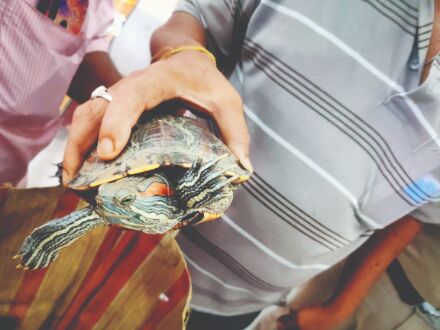Forest officials to hand over Red Eared Slider turtle to Alipore Zoo

KOLKATA: The forest division of South 24-Parganas district has taken measures to ensure that the semi aquatic turtle Red Eared Slider, found from a pond in Joynagar in South 24 Parganas, is not released in any water body. Rather, it will be given to Alipore Zoo as it is harmful for other species living in water.
The turtle was handed over by the residents of Chaltaberia village to the forest officials after it was caught in a net on Wednesday.
"Red-eared sliders are native to the Southern United States and northern Mexico are considered a major threat to native turtle as they mature fast, grow larger, and produce more offspring, and are very aggressive. They can out-compete native turtles for food, nestling, and basking sites because of their aggressive nature. As they eat plants and animals, they can finish off a wide range of aquatic species, including fish and rare frogs. So it is very harmful to the biodiversity in waterbodies," a senior official of the Forest department said.
Milan Mondal, District Forest Officer (DFO), South 24 Parganas said this species is the latest favourite of pet lovers because of its small size and colour and finds its place in aquarium.
"We have taken it in our safe custody and will hand it over to the Alipore Zoo authorities on Friday," he added.
The red-eared slider is included in the list of the world's 100 most invasive species published by the International Union for Conservation of Nature (IUCN) and is most commonly traded species of turtle in the world.
"There have been instances when people finding it difficult to accommodate these turtles in aquariums as they grow bigger sometimes release them into waterbodies ignorant of the fact that they are one of the world's worst invasive species. Such case may have happened for this too. There is no prohibition on trading of this turtle in Wildlife Protection Act," Agni Mitra, Regional Deputy Director Wildlife Crime Control Bureau (Eastern Region) said,
The species originated from the area around the Mississippi river and the Gulf of Mexico, they live in still and warm waterbodies such as ponds, lakes, streams, and slow- running rivers.



